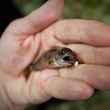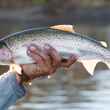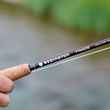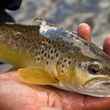Every July, I take a multi-week western road trip to visit my brother in West Yellowstone, work a few clinics in ID and MT, and chase trout amongst some of our nation’s most beautiful landscapes. While many making the same trip would be anticipating the highlight reels of themselves fooling large trout with an amazing, mountainous backdrop, I often find myself asking “why am I leaving the topwater bass bite back home?” I’ve become torn between spending my time chasing trout out west or staying close to home to pursue large smallmouth bass that love to take surface flies.
I consider trout to be my first love, but in recent years, I’ve come to enjoy the diversity and challenge of targeting other fish species. Smallmouth bass have become my “go-to” species on my home waters, when local trout streams are running low with warmer temps—especially during the summer season when these bronze color studs have a proclivity for surface feeding. I’ve only been pursuing smallmouth bass for the last eight summers, so I am far from being an expert in this field, but I feel my 50-plus days of chasing smallies each year qualifies me to share a few bits of advice that can benefit beginner smallmouth anglers.
While nymphing and streamer tactics are viable options during the summer months, these few simple tips should help you target topwater summertime smallies. These tips have served me well on Pennsylvania’s smallmouth rivers, and will likely serve you well wherever you chase smallmouth, but it’s worth noting that some of the concepts discussed here may not apply to your home waters.
You Don’t Always Need to “POP” the Popper
A common mistake I made during my early days of bass fishing was aggressively “popping” the popper in flat and calm water. A great tip I got from Tim Landwehr’s book, Smallmouth: Modern Fly Fishing Methods, Tactics, and Techniques, was to present the popper, let it sit in the film, and wait until the ripples (created by the impact of the popper landing) disappear before imparting any action to the fly. And by action, I mean just enough movement with the rod tip and/or line hand to pulse the body and legs of the popper—just enough to create a small disturbance.

If you make a cast and have a large bass slowly rising to the popper, the worst thing you can do is put movement into the fly, especially an aggressive movement. Let the popper drift when you see a fish checking out the popper and only twitch the fly a bit when you see the fish losing interest or swimming away from your fly. The only times I aggressively work a popper is when I’m blind fishing (i.e. fishing while not seeing any fish) deep, broken, dirty water, or when fishing around log jams. These are situations when I’m trying to pull fish away from the comforts of depth and structure and getting their attention may require some aggressive popping. Usually, I treat popper fishing the same as I do when drifting dry flies to trout—a slow natural drift without movement.
Let the conditions dictate the level of aggression with which you work the popper, but you may find a passive presentation may prove more useful.
Wait for a visual target before casting
I don’t blind cast often during the late summer season when our streams and rivers are running low and clear. Most of my topwater fishing involves floating calm, flat, and clear water where you can see smallmouth bass or structure from a distance. I rarely blind cast in such conditions. Instead, I’ll simply wait until I see a cruising fish or a likely ambush spot.
Smallmouth in the flats I fish tend to cruise rather than stay still. If you prefer blind casting into the abyss, there’s a good chance a smallmouth will sneak up on you from a different direction. My preference for flats is to stand and scan until I see something to cast to. The river sections I fish are not known for fish numbers but hold some quality fish. This means I may only have a handful of opportunities during each float, so I want to make sure I’m ready to strike when the time comes.
The few times I do blind cast is when targeting shaded banks, large boulders, overhanging trees, submerged logs, or any fishy looking spot you suspect to be a quality smallmouth ambush location.

Lead the Fish 5-10 Feet
Quality smallmouth cruising the flats are on high alert and will easily spook after a poor cast. Such fish will scatter if you aggressively land a popper too close. The calmer and clearer the water, the greater distance you’ll need to place the popper away from the fish. Fish have a lateral line to sense movement from prey and predators and can easily feel the impact of a cork-style popper landing 5-10 feet away. I’ve made terrible casts where my popper lands 20’ from a cruising bass, only for the fish to feel the plop and turn or travel to locate and eat my fly.
If you’re fishing from a boat, try to land the fly so the fish moves away from you rather than leading the fish to the boat. On my home waters, if a fish is 20 feet or less from my boat, my chances of getting the fish to confidently eat the popper greatly diminishes. The closer the fish is to the boat, the less confident it typically will be in deciding to eat. When it comes to streamer fishing in deeper water, I’ve had a number of situations where bass eat about a rod’s length away, but I’ve never had this happen when fishing for quality smallmouth in calm water.
Set the Hook with “God Save the Queen”
I first heard this common turn of phrase while headhunting large trout with dry flies in New Zealand. Larger trout often take a surface fly with caution, slowly closing their mouths. As a result, Kiwi guides tell their clients to wait to set the hook until they recite the phrase “God save the Queen.” This gives the fish time to inhale the fly and close its mouth before setting the hook. If you set the hook too fast (i.e. before the fish closes its mouth around the fly), you’ll likely miss the fish.
The larger smallmouth on my home waters are very similar to trophy trout rising to a dry fly in that the takes are slow and calculated. Many times I’ve seen smallmouth suspend under a popper for what feels like an eternity before deciding to eat or refuse the fly. And when they eat, it's like watching a slow-motion video as the fish slowly rises, carefully inhales the popper, then leisurely closes its mouth.
It’s easier said than done, but pause for a moment before setting the hook on a lunker gulping down your popper.
































Comments
Ed Mayhem replied on Permalink
I'm no expert but as an avid smallie angler I think the above represent some killer points for folks to keep front of mind. Personally, I have adopted referring to 'poppers' as 'bugs' so folks do not feel so inclined to pop them, rather make a good cast and let it ride. As Karcynzski & Landwehr wrote in their book SMALLMOUTH, the landing of the bug from your cast is the first pop!
Pages